Perfect Your Time Management Techniques
Welcome to the Time Management Skills Ultimate Guide, a comprehensive resource designed to empower you on your journey towards effective time management.
If you’ve found yourself scouring the web for ideas, reading countless books and articles, and watching videos on time management and goal setting, you’re not alone. The desire to be more organised, reduce stress, and get more done is a common pursuit.
Are you ready to unlock the secrets to mastering time management? To elevate your skills, establish effective systems, and revolutionise your productivity? If you’ve been tirelessly searching for that game-changing solution to take your time management abilities to new heights, look no further. Your quest for unparalleled time management ends here.
The key is not to prioritise what’s on your schedule but to schedule your priorities.”
– Stephen Covey

This Ultimate Guide will Cover:
- What is Time Management?
- How Does Time Management Work?
- The Challenge
- Don’t Be Jealous of Other Time Management Masterminds
- What 14 Years of Teaching Have Taught Me
- 4 Types of Time Management Skills Learner
- Combining Kahler’s Drivers with Time Management
- A Life Skill
- Tips & Tricks
- The 7 hurdles to jump
- Examples of the 7 Hurdles in Action
- The Core of a Healthy Time Management System
- What Next? Take the Challenge
1) What is Time Management?
Here is a Time Management Skills Definition: the process and planning you put into your everyday activities, to control the amount of time you spend on each activity, it should help you prioritise and plan your personal and professional workload, all with a view to improving your effectiveness & efficiencies.
You will have examples of strategic time allocation skills at work and home, some of which work for you, others that may need tweaking. The below approach will help you improve your skills in time management.
2) How Does Time Management Work?
If you complete all 7 exercises in the Challenge, over the next 7 weeks, you will become less overwhelmed, be more proactive, and be able to finish what you start. But more on this later.
The research on creating habits shows us that to make a piece of behaviour habitual we need to do it a minimum of 21 times. So, you need to do each one of these for a good amount of time before it sticks. If you do ‘fall off the wagon’ this is ok, as it’s a little like tuning in an old radio. Sometimes you’ll get the station, other times you’ll just hear a crackling sound. But if you keep at it you’ll eventually hear the music.
One of the most effective ways to stick with it is to share what you are doing with someone else so that they can be your conscience. Find a ‘learning buddy’ and share your effective strategic time allocation skills examples.
Check out the Eisenhower Matrix matrix below for a quick cheat to prioritisation.
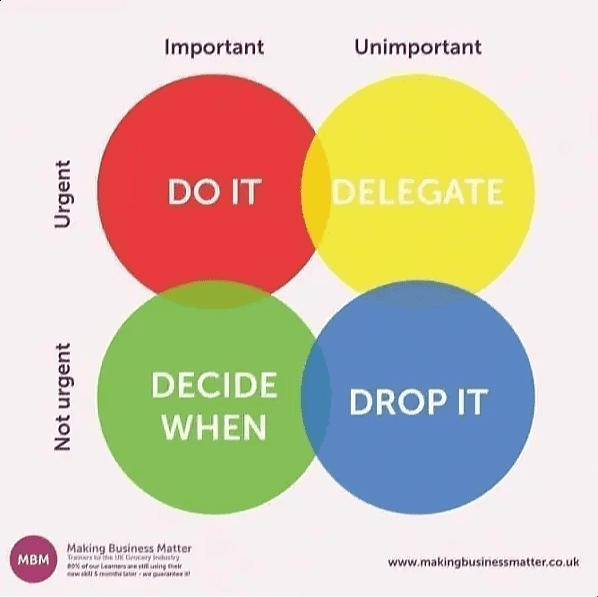
In our time management training course, we train our Learners in these hurdles of course, and then 5 advanced pieces of a healthy time management system, like ‘switching’. This is one time management skills example.
3) The Challenge
This challenge is not about time management tips or time-saving ideas. It is about your personal time management skills examples and systems (cue laughter).
Yes, I know you think that you don’t have one, but you do. Really, you do. You may not like it and even hate it for making you late for a meeting. It might even clutter your brain and make you forget stuff like a birthday. But you go to work, you hold down a decent job, and you may even be doing very well. So, you have time skills and a time management system. Now that that’s sorted let’s move on…
This guide will take you about 20 minutes to read (this is at an average reading speed of 200 words per minute with 60% comprehension). The length of this paper has been purposefully chosen to be read in 20 minutes because this is about the maximum time we can concentrate.
Now, is reading this document going to give you a positive return on your time invested? You decide. Just know that if you can improve your time management system by 0.1% each day, after 10 years it will be 1,004% improved!
I hope you find both this guide on how to improve your skills in time management and the challenge useful and I wish you every success.
4) Don’t Be Jealous of Dave Allen, Brian Tracy, Tim Ferriss, or the Other Time Management Masterminds
…Their personal time management skills systems wouldn’t work for you. You have to create your own system. Of course, there are tips, parts that you could use, and bits you could add on. For right now your system is YOUR system. And like your cooking skill, your ability to play cards, or how well you network, you cannot just grab someone else’s way.
You need to build your system, your way.
If you succeed in completing the Take the 7 Week Time Management Challenge you will be in the top 10% of effective time managers.
5) What 14 Years of Teaching Strategic Time Allocation Skills Have Taught Me
So what about People Learning Time Management…
People want to learn how to be more efficient and more effective with their time but they don’t have the time to!
Of course, this is ironic. A little like wanting to be better cooks. We buy cooking books, download recipes, and watch the chefs on TV. But when it comes to it, after a long day, we choose to heat something up, rather than cook from scratch. The only difference is that whilst home-cooked food is lovely, good strategic time allocation skills examples open so many more doors.
The key to how to manage time is about making that critical choice early. This is the key decision. It’s not what we want to change in our skills in time management, but how prepared are we to go out of our own way, change, unlearn some stuff, and learn some new stuff? This will be important to developing your effective skills in time management.
In my experience, people become one of 4 learners when they learn time management, based upon a subconscious decision made long before starting the training.
Procrastinating can be a learners’ biggest challenge, and ironically the reason they often put off learning about time management. Learn about how to stop procrastinating with our infographic below.
Click on the image for a high-resolution PDF:
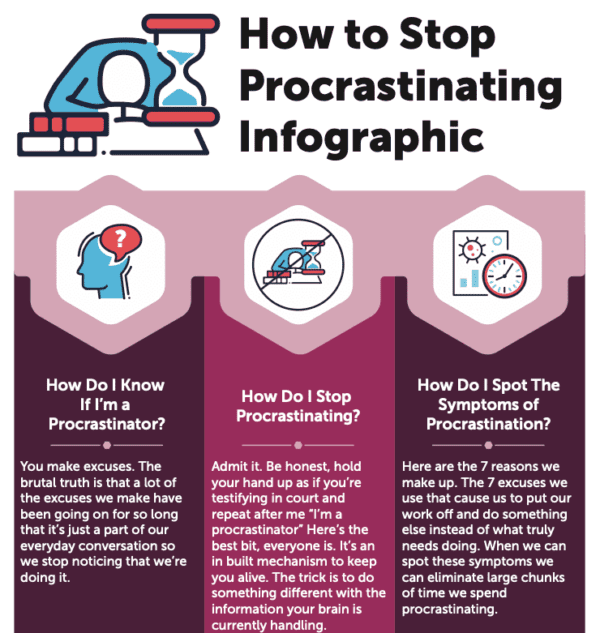
6) 4 Types of Time Management Skills Learners
#1- Learner A: ‘I’m just too busy for all of this’ – Those that Believe that They Don’t Have the Time
Many people fall into this category because busyness is spreading like a disease. In essence, they want empathy for how busy they are. They want us to know how busy they are: How important they are. The shame is that a trainer can empathise and understand. Unfortunately, however, all of the trainer’s time will have been spent doing that and not helping the learner with their effective time allocation skills.
#2- Learner B: ‘I’m doing most of this anyway’ – Those That are Already Doing All of That
Some people attend effective time management skills training just to want affirmation that they are doing it already. And some are, but most aren’t. They hear what they want to hear because to hear anything else means that they need to change. And change hurts, takes time, and is distracting from what they really want to do, which is to get back to their desk and just work – get their nose back to the grindstone.
#3- Learner C: ‘I can do all of this, I know I can’ – Those That Want to Grab it All Now
There are those people that despite the friendly words of caution about not trying to grab all of the good time management skills tips, tricks, fundamental changes, and learnings, they then do exactly that. In their own mind, they are saying to themselves, ‘mere mortals can’t do all of this, but I can.’ Sadly, they revert back to their old time management system some weeks later because the new one was too unwieldy to keep up.
#4- Learner D: ‘I can do this; Slowly and Steady’ – Those That Build Their Own System
This group has got it licked. They understand that their good time allocation skills system is the right system. It’s the foundation to build on. These people add/delete/improve one piece at a time.
They’re like the hare and the tortoise. They have recognised that time management is the one skill that unlocks everything else and they are going to take their time to get it right. ‘Slow and Steady Wins the Day’. Like the tortoise.
Watch the video below.

7) Combining Kahler’s Drivers with Time Management Skills
How to improve time management skills? In 1975 Taibi Kahler identified five common drivers that motivate us: be perfect, be strong, hurry up, please others, and try hard. These drivers live in our unconscious thoughts and can be the source of positive and negative (or destructive) behaviours.
By developing greater awareness of which driver a person exhibits it is possible to recognise and harness the positive benefits, whilst also being mindful of, and addressing the negatives.
Combining Kahler’s drivers with time management is very powerful. This is because whilst we can learn time management tips, the real difference comes in understanding our approach. Taking each driver in turn, this is the impact on time management.
Click the image below for an overview of the drivers.
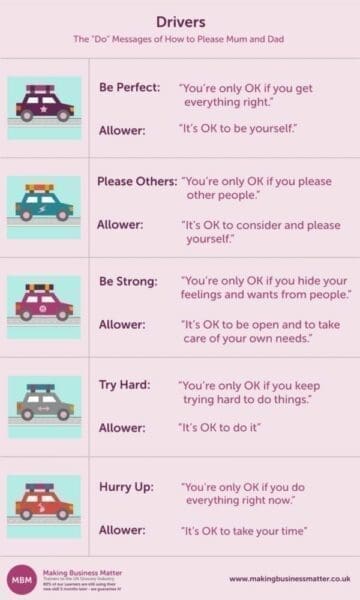
#1- Be Perfect
Those people with this driver will struggle to get a lot done. Essentially, they will be prone to procrastinating because they’ll struggle to get it done ‘properly.’ For these time managers prioritising the right tasks is imperative and, living by the phrase ‘Good enough’, for tasks that are internal, or less important.
#2- Please Others
The risk for these people is saying yes too often. One of the biggest challenges in time management is saying ‘No.’ That is, saying no to what is neither urgent nor important. Too often people say yes and then let the person down. For these people ‘saying yes wisely’ is a phrase to live by, to please the ‘right’ people.
#3- Be Strong
Being strong has its strength, as does every other driver. The danger of this driver is trying to do it alone. Getting it done yourself is admirable until you realise that you are a resource and a finite resource. Asking for help is sometimes the right thing to do. This is because these people cannot be good at everything. The phrase, ‘Ask an Expert’ is one to live by.
#4- Try Hard
For the ‘Try Harders’ the risk is that they love ‘starting fires’. Getting involved in lots and then their enthusiasm tends to wane. Starting fewer things will help. Being clear on what stirred their enthusiasm at the start can help to prolong the energy. Ultimately these people need to be clear on what is needed and by when.
#5- Hurry Up
These people are energised by deadlines and will get a lot done. Being clear on what needs to be done is important as they work well with structure. The risk is that in their enthusiasm to get a lot done, they will miss things, drop things and their accuracy will reduce. The phrase to help these people is ‘Less haste, more speed.’ Taking a little more time to check their work will save time in the future.
Excuse the Interruption, but Here’s a Little Bit About Us…
We are the soft skills training provider to the UK Grocery Industry, helping Suppliers to win more business. They choose us because of our money-back guarantee, our relevant experience, and because we make their learning stick.

8) Become a Student of Time Management Because it’s a Life Skill
Time management skills are a category of soft skills that unlocks everything else. If you want:
- Better life balance – better skills in time management will get you home on time.
- More money at work – better time management skills will get you promoted.
- To go to the gym – better skills in time management will help you get fit.
I am a huge fan of any time management & time-saving tips, like ‘67 Time Management Tips to Quickly Increase Your Productivity,’ or books like ‘Eat That Frog,’ or blogs, such as ‘Perfect Time-Based Productivity,’ or 1 Minute Time Management Tips videos.
I find that following organisational plans like the one below also help with my time management. A tidy, organised, and efficient workspace saves time – and often my sanity too – from no longer misplacing important files amongst the clutter!
3 Zones
It’s a simple method to follow, organise your space into the following three zones:
- Within Reach [Zone 1] – Things you need frequently, e.g. notepad.
- A Stretch [Zone 2] – Frequently used files that are too big to store on desks.
- A Few Steps [Zone 3] – Items such as your printer.
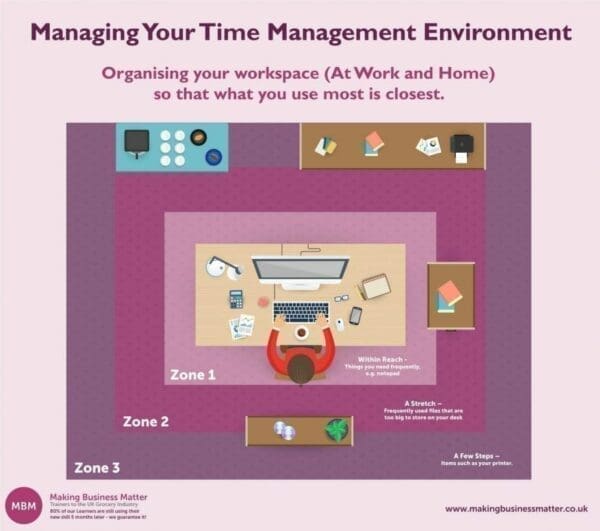
Think about how you could better arrange your workspace. Are the items you use most often closest to you? If not, take some time to rearrange your space, it will pay dividends in the future!
The return on investment of spending time learning and practising time management, versus the reward, is always positive because you’ll always take something away.
Sure, you can learn to get more from your learning. But at least you are learning something and moving forward. And with time management, learning something is better than learning nothing because some of it will stick. Plus, remember, that we learn more from what we get wrong than what we get right.
9) Tips & Tricks
The ‘rub’ is that tips and tricks will help, but they will not tackle the core of your time management that makes it healthy. A ‘healthy’ time management system is one that you trust. It should enable you to get the most important things done, in turn, reducing your stress. Not increasing it!

My advice is to keep learning tips and tricks. Just know that of Pareto’s 80:20 law you are improving the 20% and not the 80%. If you want to continue fixing the 20%, then don’t read on. If you do want to improve the 80%, then take the ‘Take the 7 Week Time Management Challenge’ and keep reading.
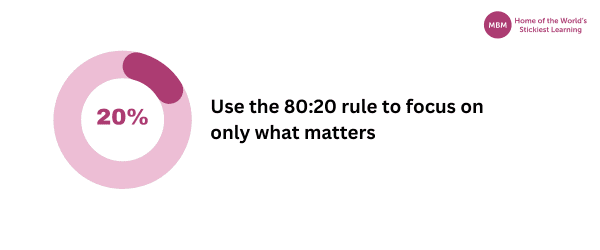
The 7 week time management challenge is about addressing the very heart of your strategic time allocation skills. Making it healthy. And living, breathing, and fit for its job, by improving your time management system. To have healthy time management they need to jump these 7 hurdles. By doing so you’ll have addressed the core of your time management system.
10) The 7 Hurdles to Jump to Have a Healthy Core are:

#1- Capturing
Capturing is about the points of entry into your time management system. Essentially, where demands on your time arrive. For example, your email inbox is a capture point. Your mind is another – particularly when you are at your desk remembering that you need to buy cornflakes after work, and then when you are in the supermarket you remember that you forgot to email that report earlier. Capture points can be mind, electronic or paper.
‘Healthy Capturing’ is not using your memory, having as few capture points as possible. Make sure that wherever and whenever you are, you have a place to enter, write stuff down, and capture it. It’s a little like the 6 pockets of a Pool table. Each pocket captures balls at different times and in different amounts. Then they need ‘Emptying,’ which we’ll come to in Hurdle #3.
#2- Listing
Listing is writing stuff down, be it old school with a pen & paper, or electronically with lists like ‘Remember the Milk’. Having the right amount of lists is key and you may have lists keeping track of lists, but if you trust them all then keep them all. Getting stuff out of your head is essential. It also gives you peace of mind that it is in a system that you can trust and that will remind you at the right time.
‘Healthy Listing’ is having lists that you trust and keeping them ‘living & breathing’ by emptying the lists frequently so that your brain is relaxed when it places something on the list that it will be looked at again. When your brain believes that a listed task will not be looked at again, it will instead choose to try to remember it. It’s a little like people on your team. Some you trust to do what you ask and others, Nah.
#3- Emptying
Emptying is about assessing and emptying the capture points frequently. For example, your email inbox is a capture point. Most people assess and try to empty it all day, continuously trying to zero their inbox. The key to emptying is doing it at an appropriate frequency and making immediate decisions about what to do with each time demand. Then have the other parts of the time management system in place that enables you to place it somewhere else.
Healthy Emptying’ is not emptying continually, but assessing with quick decisions and then doing this process again the right number of times through the week. It’s a little like emptying the dishwasher. If you don’t empty it the dishes will just keep stacking up until you then make more work for yourself having to empty the dishwasher, load it, and wash it up.
#4- Deleting
Deleting sounds easy, but is harder than it seems. We’ve all heard the urban myths of people getting back from holiday and deleting all their emails, declaring in an arrogant voice, ‘Well, if it’s urgent, they’ll write back’. Knowing full well that no one has ever done that, or at least no one that is still employed at the same company!
Considering the right question is key to effective deleting and that is ‘What is the impact if I don’t action this?’ According to research, we should be deleting 50% more of our emails than we do, which will still have little impact on our time management and performance.
‘Healthy Deleting’ gets rid of those time demands, or tasks, that don’t need to be done by you. Just because the task came into your system does not mean that you have to do it. Saying ‘Yes Wisely’ is a great way to say no to some tasks and offer options instead.
Another is to delete emails that you have been copied in on. As well as having regular 121s with people that tend to brief tasks via email, maybe you could solve some tasks in the meeting, defer them, or suggest someone else. This adds to your time management skills.
#5- Storing
Storing is not about using your head because of the old adage, ‘The most successful people are those with the emptiest heads’. Instead, Storing is about keeping the right stuff in the right places and making it available at the right time. For example, a tool for placing websites to read later, like ‘Later this’. Stored information must be kept to a minimum and, where possible, backed up so you never have to find all of that information again.
‘Healthy Storing’ is having a trusted number of useful storage points. These are convenient, available and easy to use when you need to. It’s a little like home. How many ‘messy drawers’ are there? Can you get what you need from the shed/garage when you need it or is it a bomb site? Are all your key documents (House insurance, Guarantees, Warranties, etc.) in an easily accessible & useable place?
#6- Scheduling
Scheduling is blocking out time for your time demands. At the moment you are likely to only use your calendar to book meetings. You could also use your calendar to block out project work, family time, weekly reviews, or preparing for meetings/presentations. A single calendar works best. An electronic diary is best because it allows you to book recurring events and coordinate with others. To organise multiple people meetings with external people I recommend ‘Doodle’ because it is just so easy to use.
‘Healthy Scheduling’ is a trusted diary that reminds you when you need to be reminded and at the right time. It enables you to schedule quickly and easily. It’s a little like an experienced PA that schedules enough to keep you on track, but not too much to be hampered by it.
#7- Acting
Acting is getting the right stuff done. Specifically, the actual doing of the work. The choice here is; can it be done in a short amount of time? Say, less than 3 minutes. Or does it require longer, like 30 minutes?
Time management masterminds recommend that if we can do it in a short amount of time then just do it. This is because there is no point in putting the time demand/task into your system for it to pop out 1 week later if it only takes a few minutes to do.
‘Healthy Acting’ is the key hurdle because this is where you do stuff. Make things happen. All the other hurdles lead to this one. Making decisions about what you do next is what you are paid to do and the better decisions you make the more you will be paid. Like an athlete training all year round, it’s about the decisions on race day that really matters.
Take your salary and divide it by 2,000. These are the number of hours we work per week-ish x52 weeks. This is then your value per hour. Avoid tasks that are valued at less than your hourly rate. Delegate, delete or automate them. And sometimes it helps to be less helpful.
11) Examples of the 7 Hurdles in Action

Below, are some real-life examples that will help illustrate how you can incorporate the 7 Hurdles into simple everyday activities.
Shopping:
- Capture: Your wife says, ‘Don’t forget the milk when you go shopping.’ You write it on a scrap of paper so you don’t forget.
- Emptying: You know that you must take a look at the scrap of paper before you go to the shops. Plus, the red whiteboard in the kitchen.
- Storing: You have a place where you and the family put items needed at the shops. It’s a red whiteboard in the kitchen.
- Listing: You have a list of the shops. Your shopping list. The item your wife mentioned – the milk – is emptied and added to the shopping list.
- Scheduling: You decided to go to the shops after work today because it is a late-night opening, and you added it to your calendar.
- Action: At the shop, you buy the milk.
- Deleting: As you place the milk into the shopping trolley you cross ‘milk’ off of the list and move to the next aisle.
Taking a Restaurant Order:
- Capture: You are the waiter/waitress and at the table ready to take the customer’s order for starters and their main courses.
- Emptying: As the customers place their order you get ready.
- Deleting: While you’re taking the order the guests try to order dessert. You steer the customer back on track by clarifying that they just need to order their starters & mains.
- Storing: The pad with everyone’s food and drinks is kept in your pocket.
- Listing: We make it easier for ourselves and the chef. We break the order down into starters and mains. Also, we separate the full details into their most easily actionable lists. Doing this helps to create clarity.
- Scheduling: Working in a busy restaurant, we may keep diners in a comfortable holding space while their food is being prepared. If we know they’re not eating for another 60-90 minutes this can be added at the right time slot to ensure the right action is taken.
- Action: Times up, chef rings the bells, shouts; “Service” and the dinner arrives on the table.
Work Email:
- Capture: You receive an email regarding a project you’re working on.
- Emptying: You check your emails according to the hare and the tortoise system.
- Deleting: It’s a circular/group email with some outdated information that is no longer required. You not only delete it, but you also let the sender know so the email stops clogging everyone’s inbox and saves time deleting it.
- Listing: Some parts of the email do require action, and are relevant to the current project. You have a list of actions related to that project and this needs to be added to it.
- Storing: You have a central storage point for this list which everyone can view and can see what you’re working on and can also contribute.
- Scheduling: The action cannot be taken until the next sprint, 4 weeks from now. You schedule the action in your diary and make a note on your store/list.
- Action: It’s the scheduled due date, you execute.
12) The Core of a Healthy Time Management Skills System
The 7 pieces at the core of a healthy time management system fit together in the following way:
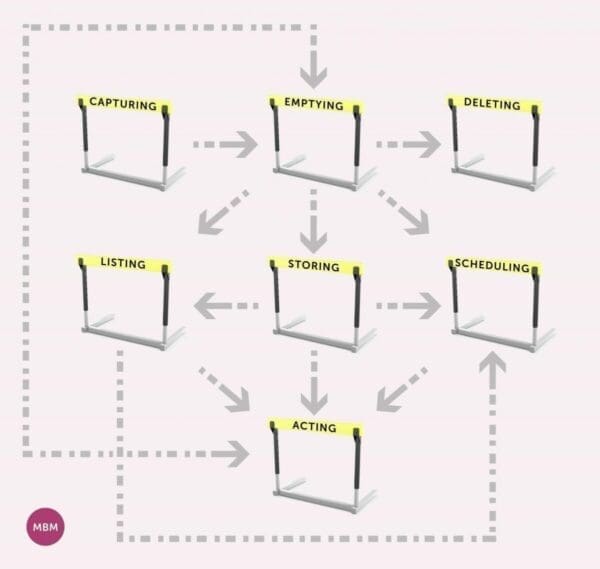
Trialists of this whitepaper found that one or two essential pieces of the time management system were of particular benefit. It helped them highlight areas where they were weak and could improve. You will probably find a similar experience.
This is What We Have Discussed in This Whitepaper So Far:
- You are someone that wants to be less overwhelmed, more proactive, and finish what you start.
- You know that you need to build your time management system and not just copy someone else’s. This is because you are an individual and so your time management system needs to be as individual as you are.
- There are 4 types of time management Learners and those that build their system ‘slow and steady’ make the most progress.
- Time management tips & tricks will only get you so far. The 20%.
- You must consciously decide how much effort you’re willing to invest because change is hard.
- Before you decide whether to take this challenge you need an excellent understanding of the 7 pieces at the core of a time management system. They are; #1 – Capturing, #2 – Listing, #3 – Emptying, #4 – Deleting, # 5- Storing, #6 – Scheduling, and #7 – Acting.
- You know how the 7 pieces fit together.
Ready to Take the 7-Week Time Management Challenge?
Let’s Go……..
To start your 7 Week Time Management Challenge, simply fill out the form below:
13) What Next?
The only challenge that remains is to keep it going! This is not easy and only those that truly commit will survive. The toughest time is when you are busiest. Don’t wait for the slow day to come because it never will. Make your system work when you are busiest because this is when you really need it to work.
You can find further insight, detailed definitions and clarification of all the key time management terms mentioned in this guide in our Time Management Glossary.
For more Advice, Subscribe to our YouTube Channel and take a look at our Time Management videos:
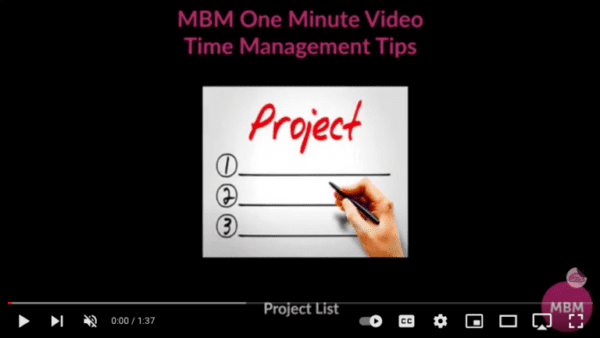
Check out Articles from Our Blog:
- Career development time management
- How to Use HBDI in Our Time Management to Make it Awesome
- Why is Forrest Gump on the Payroll? Improve Time Management
- Why Being More Assertive Can Improve Your Time Management
- Managing Time: How it’s Like the Queue at Your Local Chippy
- Time Management Model
- Work Smarter
- How to Use a Training Management System to Manage Your Time
- Get Organized with 14 Time Management Templates
- 2 Ways to Stop Being Very Last Minute With Your Time Management
- Solve Time Management Problems With Discretionary Time
Contact Us
Feel free to get in touch to find out how one of our Time Management Training Courses can help you. Simply visit our contact us page or email us at helpme@makingbusinessmatter.co.uk, and we will be happy to get back to you.




